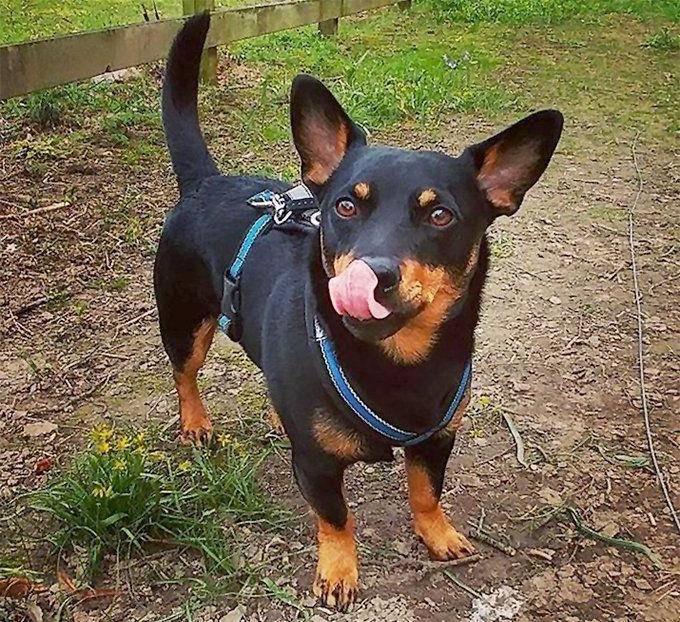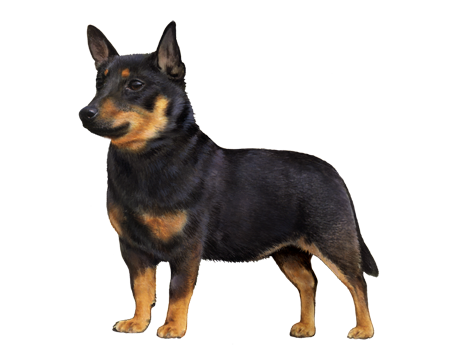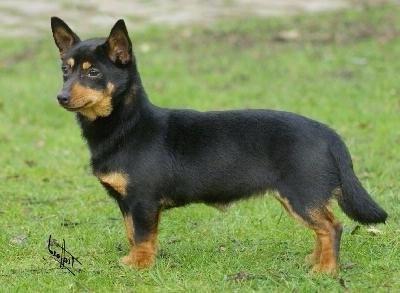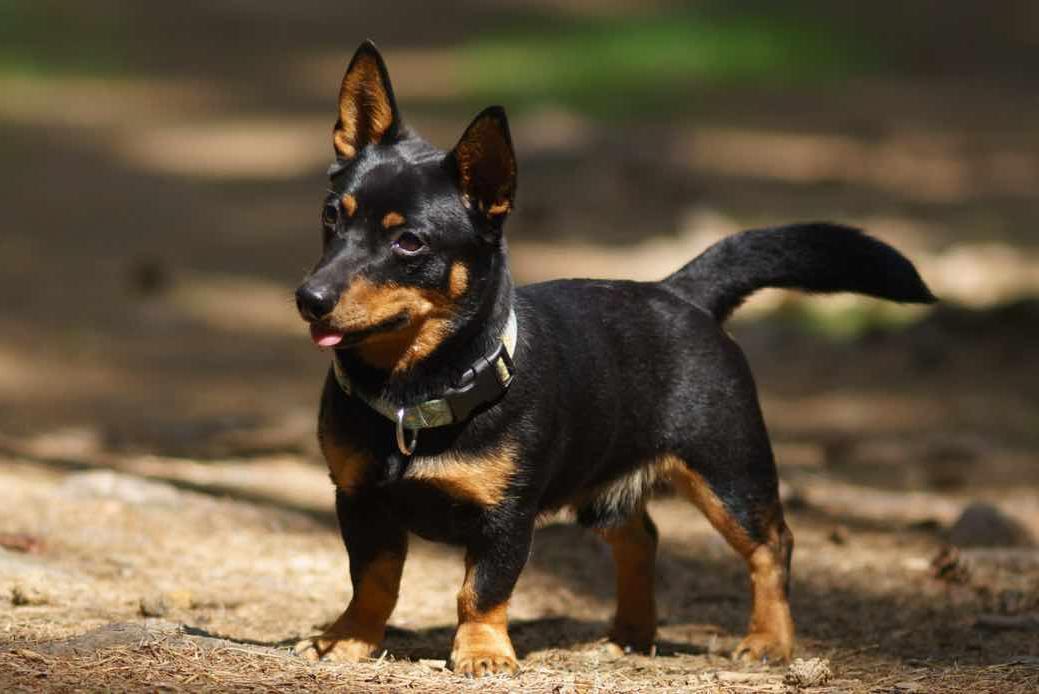- Breed Category: Herding
- Country of Origin: United Kingdom
- Average Height: 25-30 cm (10-12 in)
- Average Weight: 3-6 kg (6.5-13 lbs)
- Average Life Span: 12-15 years
- Grooming Requirements: Low, occasional brushing
- Exercise Requirements: Moderate, daily walks
- Coat Type: Short, dense
- Coat Color Variations: Black and tan, liver and tan
- Shedding Level: Moderate
- Ear Type: Erect
- Tail Type: Curled over back
- Temperament: Intelligent, alert, friendly
- Intelligence Level: High
- Barking Tendency: Moderate
- Compatibility with Children: Good with supervision
- Compatibility with Other Pets: Generally good
- Training Ease: Relatively easy
- Common Health Issues: Eye problems, patellar luxation
- Dietary Needs: Balanced, high-quality diet
- Energy Level: High
- Drooling Tendency: Low
- Sensitivity to Weather: Moderate, dislikes extreme cold
- Overall Maintenance Level: Low
- Original Purpose: Cattle herding
- Year of Recognition by Kennel Clubs: 1981
- Apartment Friendly: Yes, with sufficient exercise
- Best Suited For: Active families, rural settings
- Cost of Ownership: Moderate
- Unique Traits: Versatile herder, keen rat catcher
Did you know the Lancashire Heeler is one of the rarest dog breeds in the world, with only a few hundred registered each year? This charming little dog, known for its intelligence and versatility, has a fascinating history and unique characteristics that make it a standout among breeds. In this article, we’ll explore the Lancashire Heeler’s origins, its distinctive traits, and how to care for one.
The Lancashire Heeler hails from the north of England, where it was originally bred for herding cattle and hunting vermin. Its small size and agility made it perfect for navigating the rugged terrain of Lancashire. Despite its working roots, this breed has adapted well to family life, offering companionship and loyalty to those who welcome it into their homes.
Early Development and Historical Significance

Origins and Purpose
The Lancashire Heeler’s journey began in the pastoral landscapes of northern England. Bred for a dual purpose, these dogs were indispensable in cattle herding and vermin control. Their compact size and nimble nature allowed them to dart around livestock and chase away pests with ease. This versatility made them a farmer’s best friend, capable of handling multiple tasks on the farm.
Key Figures in Breed Creation
While the exact origins are somewhat shrouded in mystery, it’s believed that the breed was developed through a mix of Welsh Corgis and Manchester Terriers. These breeds contributed to the Heeler’s herding instincts and keen hunting abilities. Over time, dedicated breeders in Lancashire refined these traits, ensuring the Heeler’s place as a reliable working dog.
Physical Characteristics
Small yet sturdy, the Lancashire Heeler typically stands about 25 to 30 centimetres tall. Its coat is short and dense, often black and tan, providing protection against the elements. The breed’s expressive eyes and alert ears give it a lively appearance, while its strong legs and compact body hint at its working heritage.
Appearance and Unique Traits
The Lancashire Heeler is a small but mighty breed, standing at just 25 to 30 centimetres tall. Its compact and agile build is perfect for its original roles in herding and hunting. The coat is short, dense, and typically black and tan, offering a striking contrast that highlights its distinctive markings. This coat not only adds to its charm but also provides protection against the unpredictable English weather.
One of the most unique physical traits of the Lancashire Heeler is its expressive eyes, which seem to sparkle with intelligence and curiosity. The ears are alert and upright, always ready to catch the slightest sound. Despite its small stature, this breed has a robust and muscular frame, hinting at its hardworking past.
Temperament and Behaviour
Known for its lively and affectionate nature, the Lancashire Heeler is a joy to have around. It’s a breed that thrives on interaction, always eager to please its human companions. While it may be small, its personality is anything but. These dogs are intelligent and quick learners, making training a rewarding experience. They are also known for their playful and sometimes cheeky behaviour, which can bring a lot of fun into a household.
Personality and Suitability

Typical Personality Traits
The Lancashire Heeler is a bundle of energy and intelligence. Known for its loyalty, this breed forms strong bonds with its family, always eager to be part of the action. Its lively nature means it’s always up for a game or a walk, making it a delightful companion for those who enjoy an active lifestyle.
Suitability as a Family Pet and Working Dog
This breed is versatile, fitting well into both family and working environments. Its herding instincts make it a natural at tasks requiring focus and agility. As a family pet, the Heeler is affectionate and protective, often forming close relationships with all family members.
Interaction with Children and Other Animals
Lancashire Heelers are generally good with children, enjoying playtime and activities. They can be a bit reserved with other animals initially, but with proper socialisation, they usually get along well. Their playful nature makes them a hit with kids, while their intelligence ensures they understand boundaries.
Training and Exercise Needs
Training a Lancashire Heeler is a rewarding experience due to its quick learning ability. Consistent, positive reinforcement works best. Regular exercise is essential to keep this energetic breed happy and healthy. Daily walks, play sessions, and mental stimulation are key to preventing boredom and ensuring a well-behaved pet.
Training, Exercise, and Health

Importance of Early Training and Socialisation
Getting a head start on training and socialisation is crucial for a Lancashire Heeler. These dogs are naturally intelligent and curious, so introducing them to various environments, people, and other animals early on helps them grow into well-rounded adults. This early exposure reduces the risk of behavioural issues and ensures they adapt well to different situations.
Recommended Training Techniques
When it comes to training, positive reinforcement is the way to go. Lancashire Heelers respond well to treats, praise, and play as rewards. Keep sessions short and engaging to maintain their interest. Consistency is key, so make sure everyone in the household is on the same page with commands and expectations.
Daily Exercise Requirements and Activities They Enjoy
These little dynamos need regular exercise to burn off their energy. Daily walks, interactive games, and agility exercises are perfect for keeping them fit and happy. They love activities that challenge their minds and bodies, so mix up their routine with puzzle toys or obedience training sessions.
Health and Lifespan
Generally healthy, Lancashire Heelers can live up to 15 years with proper care. Regular vet check-ups, a balanced diet, and maintaining a healthy weight are essential for their well-being. Like all breeds, they can be prone to certain genetic conditions, so it’s wise to be aware of any potential health issues.
Health and Care

Common Health Issues
While generally robust, Lancashire Heelers can face some health challenges. Eye conditions like primary lens luxation and persistent pupillary membranes are known issues. Patellar luxation, a knee joint problem, can also occur. Regular vet visits are crucial to catch any potential problems early.
Average Lifespan and Health Tips
With the right care, these dogs can live up to 15 years. A balanced diet, regular exercise, and mental stimulation are key to a long, healthy life. Keep an eye on their weight to prevent obesity-related issues, and ensure they have plenty of opportunities to stay active.
Preventative Care Recommendations
Routine vet check-ups are essential. Vaccinations, dental care, and parasite prevention should be part of their health regimen. Regular eye and joint assessments can help catch any issues early, ensuring your Heeler stays in top shape.
Grooming and Maintenance
Their short, dense coat is low-maintenance, requiring only weekly brushing to remove loose hair. Bathing is needed only occasionally. Regular nail trimming, ear cleaning, and dental care will keep them looking and feeling their best.
Coat Care and Grooming

Coat Care and Grooming Routines
The Lancashire Heeler’s coat is short and dense, making it relatively easy to maintain. A weekly brush is usually enough to keep it looking tidy and to remove any loose hairs. This routine not only helps in keeping the coat healthy but also strengthens the bond between you and your dog. Regular grooming sessions are a great opportunity to check for any skin issues or parasites.
Shedding and Seasonal Grooming Tips
While the Heeler doesn’t shed excessively, you might notice an increase during seasonal changes. During these times, more frequent brushing can help manage the shedding and keep your home fur-free. A good quality brush designed for short-haired breeds will make this task easier and more effective.
Diet and Nutrition
A balanced diet is crucial for the Lancashire Heeler’s health and vitality. High-quality dog food that meets their nutritional needs is essential. Look for options rich in protein and healthy fats to support their active lifestyle. Always ensure they have access to fresh water, and monitor their weight to prevent obesity. Treats can be used for training but should be given in moderation to maintain a healthy weight.
Nutritional Needs and Feeding Guidelines

Nutritional Needs for Optimal Health
Feeding your Lancashire Heeler a balanced diet is key to ensuring they stay healthy and energetic. Opt for high-quality dog food that provides a good mix of protein, fats, and carbohydrates. Protein is particularly important for maintaining their muscle mass and supporting their active lifestyle.
Foods to Include and Avoid
Include lean meats, fish, and vegetables in their diet for a well-rounded nutritional profile. Avoid foods high in artificial additives, sugars, and unhealthy fats. Human foods like chocolate, grapes, and onions are toxic to dogs and should be kept out of reach.
Feeding Schedules and Portion Recommendations
Establish a consistent feeding schedule, typically twice a day, to help regulate their metabolism and prevent overeating. Portion sizes should be based on their age, weight, and activity level. Consult your vet for specific recommendations tailored to your dog’s needs.
Fun Facts and Trivia
Did you know that the Lancashire Heeler’s small size doesn’t stop it from having a big appetite for adventure? These dogs were once used to herd cattle, showcasing their impressive stamina and agility. Despite their working dog roots, they adapt well to family life, making them a versatile companion.
Interesting Tidbits and Famous Lancashire Heelers

Interesting Tidbits about the Breed
The Lancashire Heeler is a breed full of surprises. Despite its small stature, it has a big personality and a history of working alongside farmers in the rugged landscapes of northern England. These dogs are known for their versatility, having been used for both herding cattle and hunting vermin. Their compact size and agility made them perfect for these tasks, and they continue to impress with their intelligence and adaptability.
One quirky fact about the Lancashire Heeler is its unique “Heeler smile.” This expression, where they curl their lips back to show their teeth, is a sign of happiness and excitement, not aggression. It’s a charming trait that endears them to their owners and adds to their playful nature.
Famous Lancashire Heelers in Media or History
While the Lancashire Heeler may not be as famous as some other breeds, it has made its mark in the world of dog shows and competitions. The breed has been recognised by the Kennel Club in the UK and has a dedicated following among enthusiasts who appreciate its unique qualities.
In recent years, the Lancashire Heeler has gained attention for its rarity, with efforts underway to preserve and promote the breed. This has led to increased interest and awareness, helping to secure its place in the canine world.
Final Thoughts
The Lancashire Heeler is a remarkable blend of intelligence and charm. This breed’s adaptability and loyalty make it a cherished companion for active families. Despite its small size, the Heeler’s history as a versatile herder and keen rat catcher highlights its impressive capabilities. Embracing a Lancashire Heeler means welcoming a lively, affectionate, and intelligent friend into your life. Consider adopting this rare breed to experience its unique qualities and contribute to its preservation.
